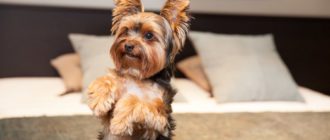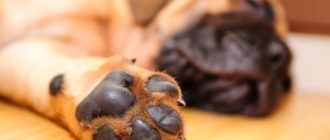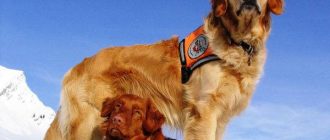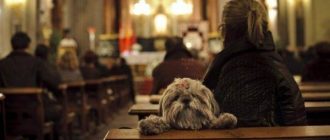Breeding work on breeding and improvement of breeds dogs are conducted without stopping, and today more than 400 pedigree varieties. Usually animals close in territorial location, have common features or options, making them recognizable all over the world. Dogs bred in Russia do not The exception is a large group of breeds with vivid features.
Content
- 1 History of domestic cynology
- 2 Overview of Russian dog breeds
- 2.1 Samoyed
- 2.2 Buryat-Mongol wolfhound
- 2.3 Caucasian Shepherd Dog
- 2.4 Russian toy
- 2.5 Russian hound
- 2.6 Siberian Husky
- 2.7 Yakut like
History of Russian Cynology
Contents
Cynology in Russia was born on the basis of a national sport – dog hunting. In the formation of science was of great importance level of technical skills of dog breeders, as many of them engaged in horse breeding. The real boom in cynology is at the end of the 19th century, when monographs about dogs began to appear, training and education. Along with the hunting direction service dog breeding also gradually developed. On the today is the largest cynological organization in Russia is the Russian Cynological Federation, which since 1995 is a partner of the International Federation, and since 2003 – its full member.
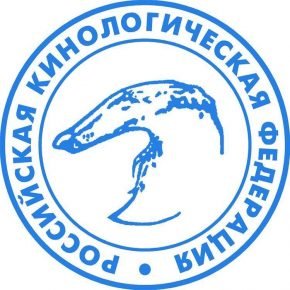
RKF since 2003 is an active member of the International cynological federation
About 30 breeds are considered Russian, a third of which are already recognized on the international level. The main and specialty is endurance and good health, since most were bred in conditions severe northern climate.
Overview of Russian dog breeds
Many Russian dog breeds, especially recognized IFFs, are known and popular all over the world. The most striking achievements of the Russian canine activities can be considered the following breed.
Samoyed dog
Samoyeds, or Samoyed huskies – medium-sized dogs (from 17 up to 30 kg, growth at the withers for males 54-60 cm, and for females – 50-56 cm). In their native form, representatives appeared in the XI century before AD, but the modern breed was formed at the beginning of the XX century. The breed is recognized by both the Russian and the International Cynological federations.
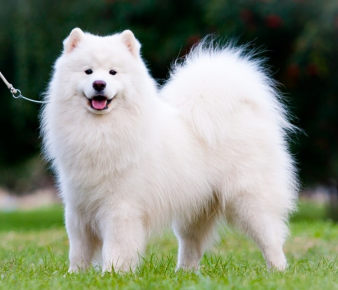
Samoyeds have white wool and a tail thrown back
Feature of appearance is white long coat and tail thrown back. Life expectancy – 12-15 years, dogs quite strong and rarely get sick. By nature, representatives of the breed very controversial, they are cheerful and friendly, but implicitly they will not obey and can show their obstinacy. Main the complexity of the content lies in education, including because of propensity for vagrancy. The rest is very playful and interesting dogs that get along well in families with children.
In fact, most people immediately see Samoyed imagine a lot of problems with caring for such a beautiful dog. In fact in fact, there’s practically no hassle, except for compliance, to some extent, a specific diet give red products, bread, etc.). Wool has the property itself is very easy to clean even after a walk in dirty weather, just comb it. It gives even more effect than swimming.
Buryat-Mongol Wolfhound
Buryat-Mongolian Wolfhound (hotosho) – guard breed, whose representatives are distinguished by good health and unpretentiousness in the content. The breed has been recognized by the RKF since 2006, but It has no international recognition. Such dogs have sustainable psyche and ability to quickly adapt to new conditions that makes them exemplary pets, especially for families with children.
Hotosho – dogs of medium height, strong physique with developed muscle corset. They have a straight and coarse coat with soft undercoat, which is allowed in 3 lengths:
- long (15–20 cm);
- intermediate (8-10 cm);
- shorthair.
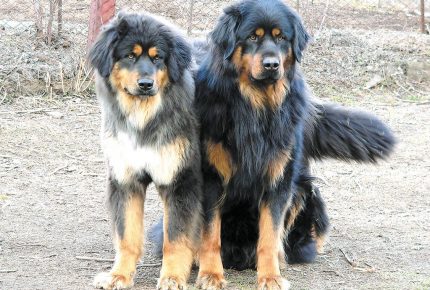
Buryat-Mongol wolfhounds – large dogs with sustainable psyche, not internationally recognized
Color is preferably tan (black with red marks). Height for males – not less than 74 cm, for females – not less than 66 cm. Hotosho requires proper upbringing and a firm hand, so it won’t do novice dog breeder. In addition, dogs are prone to active molting. in the summer, and regardless of the length of the coat.
Caucasian Shepherd Dog
The Caucasian Shepherd, or Wolfhound, is large, strong and muscular dog. The growth of bitches is not less than 64, in males – 68 cm at the lower border of the weight is 45 and 50 kg, respectively. She has massive and long body, wide head with high set ears, short muzzle with a large black nose and dark almond-shaped eyes. The coat may be short, intermediate and long. More often total gray coat with rusty shades is found, but the dog can be beige, white, cream, brown, striped or spotty. The breed is recognized by both the RKF and the IFF.
Wolfhounds are famous for their brave and vigilant guards, they are true serve their master and protect the family. Incredulous and independent character makes them wary of strangers. By he usually seeks to dominate his relatives, but with children gets along well.

Caucasian Shepherd Dogs have a sophisticated protective instinct
The main minus of the animal is innate aggression towards strangers, which requires proper education and early socialization. But a significant plus can be considered endurance and ability to quickly adapt to any climatic conditions. Such a dog lives in an average of 10–11 years, characterized by good health. Danger represent ailments characteristic of large breeds (dysplasia joints, inversion of the stomach, etc.).
Once upon a time, about 17 years ago, I had Caucasian shepherd dog. She was with the same analytical brains, 67cm tall withers, broad-chested, lightning-fast in throws, with an easy move. Now you will see such units, and then on the periphery away from the centers “dog breeding”, easier – away from megacities, where owners little touched the laws of dog show business. I recently went to Moscow to the Mayor’s Cup, the World Cup, but the old-fashioned Caucasus, Of course I didn’t. Mostly lead into the ring of elephant monsters.
Russian toy
Russian Toy – a breed whose work on the creation was carried out in in the middle of the 20th century in the USSR in order to get decorative pets, like English toy terriers. The breed is registered in the system RKF, and in 2017 received recognition on an ongoing basis in ICF system. Visually, these are small (20–28 cm at the withers) dogs on tall and thin limbs with dry muscles. On the head a striking feature of the breed is located – large ears, in shape reminiscent of a candle flame. Today there are two varieties of toy:
- smooth-haired (with a short, tight-fitting and shiny wool);
- long-haired (with moderately long, 3-5 cm hair, straight or slightly wavy).
Colors are allowed in several versions: black, purple and brown-tan, fawn, red any shade, including with dark bloom.

Russian toi are energetic companions devoted to their to the owner
By nature, the Russian Toy are energetic, active and playful. dogs loyal and affectionate to their master. The psyche of an animal subject to stress, so next to noisy young children It’s not worth living. In content, it is a simple pet, you can train it walk on the tray. The main disadvantage is health, due to the size of the animal hard tolerates mechanical, viral and temperature exposure. The average life expectancy is 13-15 years.
The breed was originally called the “Moscow Toy Terrier”, but in the time of the international recognition procedure was not a commission noted in representatives of the signs of the terrier, so this word just been removed from the name.
Many say that this dog is not for families with children, and in people because of this, a stereotype develops, which is not for children – which means hates children, aggressive, etc.) in fact, everything is just on the contrary – this gentle dog is gentle not only in soul and heart, but also no less tender with her fragile body. kids just not calculating of one’s strength or activity, can damage or ruin it small animal. I saw orthopedic surgery on toy terriers – knitting needles enter the bones. like in oil, such bones really very easy to break. let the kids mute the shepherd or Labrador, do not buy a toy for young children!
Russian hound
The exact time of the origin of the Russian hound is unknown, but it is believed that this happened in the 5-6th century. Purposeful work over the breed was conducted from the second half of the XIX century in Russia. Today representatives of the breed are used as fox and hare hunters. IN RKF system it is, but at the international level is not recognized.
They are medium-sized dogs weighing 25–30 kg and are tall at the withers. from 55 to 68 cm. Representatives of the breed are strong and muscular, have a small head and an elongated muzzle. Exterior Feature – hanging triangular ears and almond-shaped brown eyes. The nature the hounds are very friendly to all family members, they are smart and unobtrusive, energetic and active. Focus is needed to devote to raising an animal, since with an incorrect or late socialization dogs can be aggressive towards relatives. If the owner does not have enough time for communication and games with the dog, then its energy will be a minus, spilling out into destructive behavior.
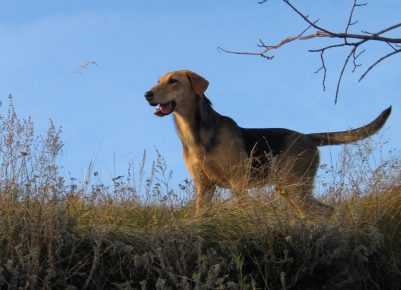
Russian hounds are very energetic dogs requiring significant physical exertion
The life expectancy of a dog is 10-12 years. Health can characterize as strong, but there are diseases characteristic of this breed (joint dysplasia, myositis (muscle inflammation)).
Siberian Husky
Siberian Husky is a breed bred in northeast Siberia, its representatives are considered sledding and companion dogs. She officially registered in the ICF system in 1966. Visually they are light and compact, with a slightly lowered back line and fluffy tail. Husky has erect triangular ears and eyes can be of any color, including different colors (allowed heterochromia). Husky’s coat is not long, but thick and warm, her color can be any, but are considered the most common white-black and gray-white.
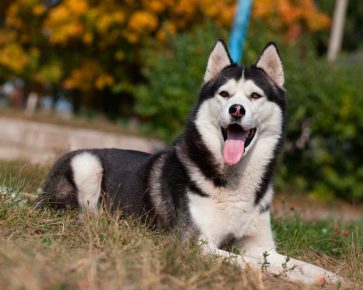
Siberian huskies were bred as sled dogs, but today they great companions
According to the IFF documentation, Siberian Husky is an American breed, since it was the American that filed for its registration dog handlers in the 1930s. However, in fact, she was withdrawn to Of Russia.
Siberian Husky is friendly and calm, but very lively and active. They categorically are not suitable for service roles, so how very independent. Great mental abilities allow It’s good for the pet to learn, but for productivity it will take frequent games and distractions. The pros can be considered their harmlessness, in in relation to children, and the big minus is the desire run away and the love of digging, including in the house.
The average life expectancy of a dog is 12–15 years. Like a breed from the northern latitudes, Siberian huskies have good health, but can have hereditary diseases like diabetes or hip dysplasia.
It seems to me that people who dream to make themselves fantastically a beautiful dog needs to know and consider key points in the nature of the husky breed in order to evaluate their strength and be sure what you can do. The first thing I want to highlight is sooo active dog. The breed was bred to help people of the North, suitable for riding, so dogs are very hardy and energetic. She accumulates so much energy during the day that walk the dog at least three times (at best, by hour). The second, even observing the walking regimen well, i.e. providing the dog expanse, you need to consider the size of the apartment. IN ideally, it is better to keep a husky in a country house or in a spacious apartment. And one more thing – huskies love to run away. This is very freedom-loving creatures and you need to control when and where you release the dog from the leash. Bayra ran away with us several times. And it almost always looked like this: you take a walk — you meet a familiar dog — you release your dog from the leash so that they played — dogs play — husky wedges from something — she’s already quivering doe, which rushes into the fog … Almost always, we caught a runaway somewhere in the bushes eating some nasty stuff (this some strange craving for eating all sorts of rubbish once almost cost Bayreux life).
Yakut like
Yakut Laika – native breed (formed without participation human) that arose in the central and western parts of Yakutia. Representatives of the breed have a strong physique, developed musculature and developed coat. One of the brightest merits – a magnificent tail, thrown back. Color allowed any spotty and pure white. Breed today in international system not recognized.
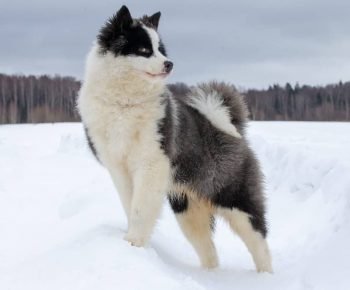
Yakut likes are very flexible
These are active, curious and sociable animals with complaisant character that can be used for riding work or hunting. They get along well with relatives and little ones. children, therefore, become wonderful family pets. But the owner will have to spend a lot of time on the dog – it’s very demanding on activity.
Yakut huskies live 9-12 years and due to their northern origin have good health. However, there are ailments that can be inherited, among them: joint dysplasia, diabetes, retinal dystrophy.
The main emphasis in the work of dog handlers in Russia was initially made on hunting, and then also on service dogs. It’s known today more than 30 breeds of Russian origin, most of which has worldwide recognition.

